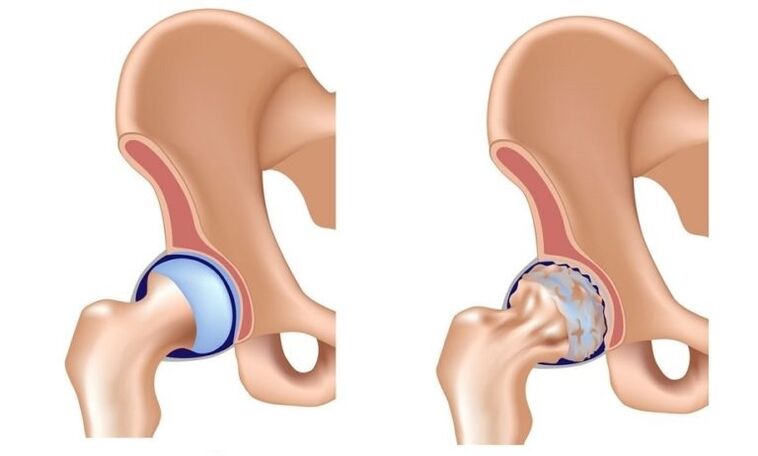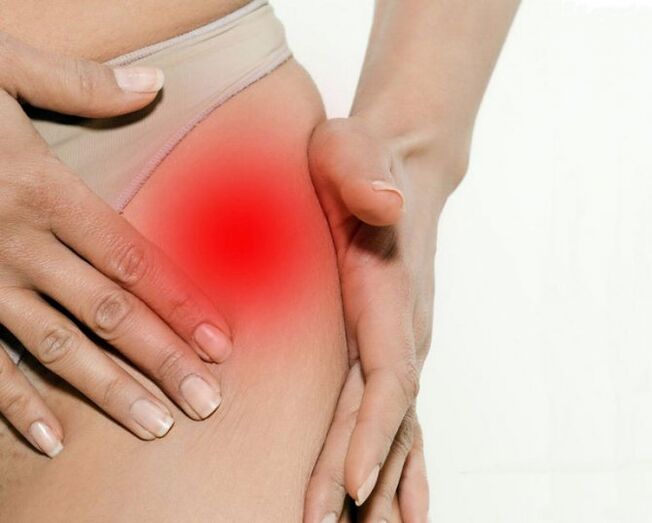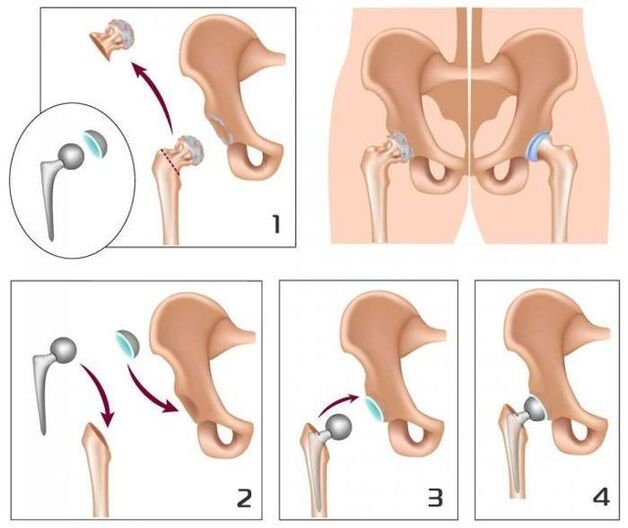
Arthrosis of the hip joint (deforming arthrosis, coxarthrosis, osteoarthrosis) is a slowly progressive degenerative-dystrophic disease, leading over time to destroy the affected joint, persistent pain and limiting mobility.
The disease affects people over 40 years old, women get sick several times more often than men.
In the overall structure of arthrosis, arthrosis of the hip joint belongs to the leading role.This is due to the widespread congenital pathology of the hip joints (dysplasia), as well as significant physical exertion, which these joints are susceptible to.
Risk factors and causes of arthrosis of the hip joint
In the pathological mechanism of the development of arthrosis of the hip joint, the main role belongs to a change in the physicochemical characteristics of the synovial (intra-articular) fluid, as a result of which it becomes more dense and viscous.This worsens her lubricating qualities.When moving, the joint cartilage surfaces begin to rub against each other, become rough, covered with cracks.Small particles of hyalin cartilage are abandoned and fall into the articular cavity, causing the development of aseptic (non -infectious) inflammation in it.As the disease progresses into the inflammatory process, bone tissue is drawn into the inflammatory process, which leads to aseptic necrosis of the sections of the femoral head and the surface of the acetabulum, the formation of osteophytes (bone growths), enhancing inflammation and cause severe pain during movement.
In the late extent of arthrosis of the hip joint, the inflammation is also thrown into the surrounding joint of the tissue (blood vessels, nerves, ligaments, muscles), which leads to the appearance of signs of periarthritis.As a result, the hip joint is completely destroyed, its functions are lost, the movement in it ceases.This condition is called ankylosis.
Causes of arthrosis of the hip joint:
- congenital lip of thighs;
- hip dysplasia;
- aseptic necrosis of the femoral head;
- Peters disease;
- injuries of the hip joint;
- infectious arthritis of the hip joint;
- gonarthrosis (deforming osteoarthrosis of the knee joint);
- osteochondrosis;
- Excess weight;
- professional sports;
- flat feet;
- curvature of the spine;
- A sedentary lifestyle.
The pathology is not inherited, but the child inherits the features of the structure of the musculoskeletal system from his parents, which can cause arthrosis of the hip joint in this conditions.This explains the fact of the existence of families, the incidence of which is higher than in the general population.
Forms of the disease
Depending on the etiology, arthrosis of the hip joint is divided into primary and secondary.Secondary arthrosis develops against the background of other diseases of the hip joint or its injuries.The primary form is not related to the previous pathology, the reason for its development is often not possible, in this case they talk about idiopathic arthrosis.
Coksartrosis is one- or bilateral.
Stages
Three stages (degree) are distinguished during arthrosis of the hip joint:
- Initial - pathological changes are expressed slightly, provided that the timely and adequate treatment is reversible.
- Progressive coxarthrosis - characterized by a gradual increase in symptoms (pain in the joint and impaired its mobility), changes in the joint tissues are already irreversible, but therapy can slow down degenerative processes.
- The final - movement in the joint is lost, ankylosis is formed.Treatment is possible only surgically (replacing the joint with artificial).
Endoprosthetics operations in 95% of cases ensure a complete restoration of limb mobility, restore the patient's performance.

Symptoms of arthrosis of the hip joint
The main signs of arthrosis of the hip joint:
- pain in the groin, hips and knee;
- a feeling of stiffness in the affected joint and the limitation of its mobility;
- lameness;
- restriction of abduction;
- Atrophic changes in the muscles of the thigh.
The presence of certain symptoms of arthrosis of the hip joint, as well as their severity depend on the degree of disease.
At the 1st degree of arthrosis of the hip joint, patients complain of the pain in the affected joint that occur under the influence of physical activity (prolonged walking, running).In some cases, the pain is localized in the area of the knee or thigh.After a short rest, the pain passes on its own.The volume of limb movements is completely preserved, the gait is not broken.The following changes are noted on the radiograph:
- slight uneven decrease in the lumen of the joint gap;
- Osteophytes located on the inner edge of the swivel.
Any changes from the neck and femoral head are not detected.
With the II degree of arthrosis of the hip joint, pain also appears at rest, including at night.After physical activity, the patient begins to limp, a characteristic “duck” gait is formed.So -called starting pains appear - after a long period of immobility, the first few steps cause pain and discomfort, which then pass and then return after a long load.In the affected joint, the volume of movements (abduction, internal rotation) is limited.The radiograph shows that the joint gap is unevenly narrowed and its lumen is 50% of the norm.Osteophytes are located both along the internal and outer edge of the joint cavity, going beyond the boundaries of the cartilage.The contours of the femoral head become uneven due to deformation.
With the III degree of arthrosis of the hip joint of pain, intense and constant, not stopping at night.Walking is significantly difficult, the patient is forced to rely on the cane.The volume of movements in the affected joint is sharply limited, later it completely stops.Due to atrophy of the hip muscles, the pelvis deviates in the frontal plane and the limb is shortened.Trying to compensate for this shortening, patients when walking are forced to reject the body towards the lesion, which further increases the load on the sore joint.On radiographs, multiple bone growths, a significant narrowing of the joint gap and a pronounced increase in the head of the femur are detected.
Diagnostics
Diagnosis of arthrosis of the hip joint is based on the data of the clinical picture of the disease, the results of medical examination and instrumental studies, among which the main value belongs to visualization methods - radiography, computed or magnetic resonance imaging.They allow not only to determine the presence of arthrosis of the hip joint and evaluate its degree, but also to identify the possible cause of the disease (trauma, youthful epiphysiolysis, Peters's disease).
The differential diagnosis of arthrosis of the hip joint with other diseases of the musculoskeletal system is quite complicated.On the II and III degree of arthrosis of the hip joint, muscle atrophy develops, which can cause intensive pain in the knee joint characteristic of drive or gonarthrosis (diseases of the knee joint).For the differential diagnosis of these states, palpation of the knee and hip joints is palpated, the volume of movement in them is determined, and they are also examined by radiologically.
In diseases of the spine, in some cases, the nerve roots of the spinal cord with the development of pain syndrome are squeezed.Pain can radiate to the area of the hip joint and imitate the clinical picture of its defeat.However, the nature of the pain with radicular syndrome is slightly different than with arthrosis of the hip joint:
- pain occurs as a result of weight lifting or sharp awkward movement, and not under the influence of physical exertion;
- The pain is localized in the gluteal, not the inguinal region.
With radicular syndrome, the patient can calmly take his leg to the side, while with arthrosis of the hip joint, the abduction is limited.A characteristic sign of radicular syndrome is a positive symptom of tension - the appearance of a sharp pain when trying to raise a straight leg on the patient’s back.
Arthrosis of the hip joint affects people over 40 years old, women get sick several times more often than men.
Arthrosis of the hip joint should also be differentiated with loyal Bursite (trochanteritis).Vable Bursitis develops faster, within a few weeks.Usually he is preceded by significant physical exertion or injuries.In this disease, the pain is much more pronounced than with arthrosis of the hip joint.At the same time, shortening the limb and limiting its mobility is not detected.
The clinical picture of atypical reactive arthritis and ankylosing spondylitis can resemble the clinical manifestations of arthrosis of the hip joint.However, pain occurs in patients mainly at night or at rest, when walking does not intensify, but, on the contrary, weakens.In the morning, patients note stiffness in the joints, which passes after a few hours.
Treatment of arthrosis of the hip joint
Orthopedians are engaged in the treatment of arthrosis of the hip joints.With I and II degree of the disease, conservative therapy is indicated.With pronounced pain syndrome, patients are prescribed non -steroidal anti -inflammatory drugs in a short course.They should not be accepted for a long time, since they are not only able to have a negative effect on the organs of the gastrointestinal tract, but also suppress the regenerative abilities of hyalin cartilage.
In the treatment regimen of arthrosis of the hip joint, they include chondroprotectors and vasodilators, which creates optimal opportunities for restoring damaged cartilage tissues.With pronounced muscle spasm, it may require the appointment of central muscle relaxants.
In those cases when it is not possible to stop the pain syndrome with non -steroidal anti -inflammatory drugs, resort to intraarticular injections of corticosteroids.
Local treatment of arthrosis of the hip joint using warming ointments allows you to reduce muscle spasm and somewhat weaken pain due to distracting action.
In the complex therapy of arthrosis of the hip joint, physiotherapeutic methods are also used:
- magnetotherapy;
- inductothermia;
- UHF;
- laser therapy;
- ultrasound treatment;
- massage;
- medical gymnastics;
- Manual therapy.

Dietary nutrition for arthrosis of the hip joint is aimed at correcting body weight and normalization of metabolic processes.Reducing body weight reduces the load on the hip joints and thereby slows down the progression of the disease.
To unload the affected joint, the doctor may recommend that patients go to the crutches or cane.
With the III degree of arthrosis of the hip joint, conservative treatment is inefficient.In this case, it is possible to improve the patient's condition, it is possible to return normal mobility only as a result of surgical intervention - replacing the destroyed joint with artificial (joint endoprosthetics).
Possible consequences and complications
The most serious complication of progressive arthrosis of the hip joint is disability due to loss of movement in the joint.With bilateral coksartrosis, the patient loses its ability to independently move and needs constant extraneous care.A long stay in bed in one position creates the prerequisites for the occurrence of stagnant (hypostatic) pneumonia, which is difficult to succumb and can lead to death.
The pathology is not inherited, but the child inherits the features of the structure of the musculoskeletal system from his parents, which can cause arthrosis of the hip joint.
Forecast
Arthrosis of the hip joints is a progressive chronic disease, which can be completely cured only in the early stages, subject to the elimination of the cause of the disease.In other cases, therapy allows you to slow down its course, however, over time, there is a need for implantation of hip endoprostheses.Such operations in 95% of cases provide a complete restoration of limb mobility, restore the patient's performance.The service life of modern prostheses is 15-20 years, after which they are subject to replacement.
Prevention
The prevention of arthrosis of the hip joint is aimed at eliminating the causes that can lead to the development of this disease, and includes:
- timely detection and treatment of diseases and injuries of the hip joint;
- rejection of a sedentary lifestyle, regular, but not excessive physical activity;
- body weight control;
- rational nutrition;
- Refusal of bad habits.

























